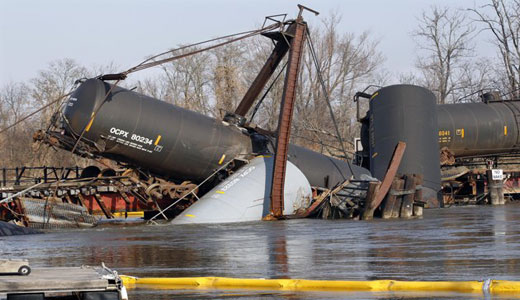
When a train derailment in Paulsboro, N.J., on Nov. 30 sent two tanker cars hurtling into a nearby creek, the water became polluted with vinyl chloride – a dangerous chemical that the tankers had contained. Now, the pollutant has become airborne, forcing the evacuation of 200 people in the South Jersey town. The evacuation is expected to last until Sunday, while the Coast Guard and other agencies attempt to dissolve what is left of the chemical in the tanker cars and remove it.
Though no deaths have occurred, the spill resulted in over 70 people checking into the nearby Underwood-Memorial Hospital on that day, complaining of breathing problems – one of the symptoms caused by short-term exposure to vinyl chloride, along with dizziness. Long-term exposure to the chemical is very dangerous, and could result in liver failure and cancer.
The two train cars currently remain in Mantua Creek, where the situation is too delicate for them to be removed until the hazardous materials they carry are disposed of. Conrail, who owned the train, are paying for hotels, meals, and other expenses for residents who have been forced out of their neighborhood, according to the Washington Post. A gym at Kingsway High School in the town of Woolwich has also been set up as a temporary shelter. Conrail is also expected to open a shelter of its own at the Paulsboro Fire Department within a few days.
Many residents were not prepared for the evacuation, as they had previously only been told to remain in their homes with the doors and windows shut. “We were not told until they knocked on our door,” said Diamond Veney, who has a one year-old son. She said her family was given just thirty minutes to leave.
Officials must first remove the vinyl chloride before they can clear the track and determine what caused the train to derail, but federal investigators said on December 2 that Conrail had reported signal problems at the railroad bridge where the accident occurred. Notably, there was also a 2009 incident where a train derailed on the same bridge, though no chemical spill followed that accident. The National Transportation Safety Board is reportedly reviewing both cases.
One theory the NTSB has is that a tidal surge from Hurricane Sandy may have caused previous damage and problems on the bridge, though Paulsboro was not severely impacted by the superstorm. Inspectors, however, have been advised to stay away from the site until the airborne chemical settles and can be completely cleaned up.
Photo: Mel Evans/AP












Comments